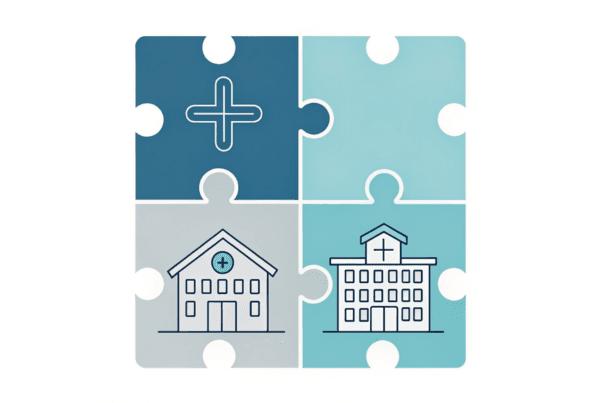As the owner of an Orthopedic and Musculoskeletal (MSK) practice in San Antonio, you’ve built a valuable asset. When the time comes to consider a sale, navigating the market to realize its full potential is a complex process. The current landscape presents unique opportunities, but maximizing your outcome requires a clear strategy.
This guide provides a direct look at the key factors shaping private practice sales in our region. We will cover the market dynamics, valuation realities, and strategic considerations to help you prepare for one of the most important transitions of your career.
The San Antonio Ortho & MSK Market: A Snapshot
If you are considering selling, the good news is that you operate in a high-demand specialty. The market for Ortho & MSK services is not just stable; it’s expanding significantly. This underlying growth makes well-run practices attractive targets for a range of buyers.
A Growing Demand for Services
Nationally, the market for musculoskeletal disease management is on a strong upward trajectory, projected to become a multi-billion dollar industry. This trend is driven by an aging population and active lifestyles, ensuring a consistent and growing patient base. For practice owners, this translates into a durable and predictable revenue stream, a key factor that sophisticated buyers look for.
The Local Competitive Landscape
San Antonio is a prime example of a dynamic orthopedic market. It is home to major players like OrthoLoneStar and TSAOG Orthopaedics & Spine. While it may seem daunting, this strong local presence is actually a positive sign. It demonstrates that the region can support high-value practices and that large, well-capitalized groups are actively investing here. Your independent practice holds strategic value for these groups and other investors looking to enter or expand in a proven market.
Three Key Considerations Before You Sell
Selling your practice involves more than just financials. In Texas, there are specific hurdles and strategic points you must address to ensure a successful and compliant transaction. First, any sale structure must navigate the state’s Corporate Practice of Medicine (CPOM) laws, which dictate who can own a medical practice. This is a critical legal checkpoint for any non-physician buyer, like a private equity group. Second, your practice’s relationship with insurance payors and its reimbursement rates will be heavily scrutinized. Finally, a clear plan for your own transition, as well as for your key staff, is not just a courtesy. It is a core component of the practice’s value and ensures the continuity of care that a buyer is paying for.
Understanding Buyer Activity in the Market
The consolidation trend in healthcare is strong, and Ortho & MSK practices are prime targets. The key is understanding who the buyers are and what they want. Finding the right fit is crucial for both your financial outcome and your post-sale satisfaction. A competitive process involves identifying and engaging with all potential buyer types.
| Buyer Type | Primary Motivation | What This Means for You |
|---|---|---|
| Private Equity Group | Build a platform, improve operations, and grow EBITDA for a future sale. | Often offer strong valuations and partnership models (equity rollover), but require a focus on financial and operational metrics. |
| Large Strategic Group | Expand geographic footprint, add talented physicians, and increase market share. | A focus on strategic fit and clinical alignment. The transition may feel more like merging with a larger version of your own practice. |
| Hospital System | Secure referral pathways, expand service lines, and integrate care within their network. | Can provide stability and resources, but may lead to less autonomy and changes in operational workflow to fit the larger system. |
The Path to a Successful Sale: A Process Overview
A successful transaction is not a matter of luck. It is the result of a deliberate and structured process. Most owners think selling starts with finding a buyer, but the best outcomes begin much earlier. The first step is preparation: getting your financial, operational, and legal documents in order to present a clean and compelling story. Next comes a comprehensive valuation to set a realistic and defensible price baseline. Only then does the confidential marketing process begin, where we create competitive tension among qualified buyers. The final stage is navigating negotiations and the buyer’s due diligence, a rigorous review where being prepared can be the difference between a smooth closing and a broken deal.
What Is Your Ortho & MSK Practice Really Worth?
Many physicians believe their practice is worth a simple multiple of its annual revenue. The reality is more complex and, often, more profitable. Sophisticated buyers don’t value your practice on revenue. They value it based on its demonstrated cash flow, or Adjusted EBITDA (Earnings Before Interest, Taxes, Depreciation, and Amortization). This figure normalizes your financials by adding back owner-specific expenses to show the practice’s true profitability. A higher multiple is then applied to that EBITDA based on quality and risk.
Here are four key factors that drive your valuation multiple:
- Provider Mix: Practices that are not entirely dependent on the owner command higher multiples. A strong team of associate physicians or physician assistants demonstrates that the practice’s revenue is sustainable after a transition.
- Payer Contracts: A healthy mix of payors with favorable, up-to-date reimbursement rates is a significant value driver. This shows financial stability and reduces risk for a potential buyer.
- Growth Potential: Buyers pay a premium for growth. This can be demonstrated through a track record of adding new service lines (like physical therapy or imaging), efficient patient acquisition strategies, or clear opportunities for expansion in the San Antonio market.
- Operational Maturity: A practice with clean financials, efficient billing and collections, and well-documented operational procedures is perceived as lower risk and is easier to integrate, making it a more valuable asset.
After the Sale: Planning for Your Next Chapter
The closing of the sale is not the end of the journey. It is the beginning of a new chapter that should be planned for with the same care as the transaction itself. Your role post-sale is a key point of negotiation. You might agree to a transition period to ensure a smooth handover, or you may choose to remain involved longer. The structure of your proceeds is also critical. Many deals include an “earnout,” giving you a share of future profits if the practice hits certain targets. Others involve an “equity rollover,” where you retain ownership in the new, larger entity. This provides the potential for a “second bite of the apple” when that larger group is eventually sold again. These structures require careful planning to align with your personal goals, whether they involve a swift exit or continued participation in your practice’s growth.
Frequently Asked Questions
What makes the San Antonio Ortho & MSK market attractive for selling a practice?
The San Antonio Ortho & MSK market is attractive because it is a high-demand and expanding specialty, driven by a growing patient base due to an aging population and active lifestyles. Additionally, the presence of major players like OrthoLoneStar and TSAOG Orthopaedics & Spine indicates a strong local market with active investment from large groups, creating strategic opportunities for independent practices.
What legal considerations should I be aware of when selling my Ortho & MSK practice in San Antonio?
In Texas, including San Antonio, you must navigate the Corporate Practice of Medicine (CPOM) laws that regulate who can own a medical practice. This is especially important if the buyer is a non-physician entity like a private equity group. Ensuring compliance with these laws is critical to a successful and legal transaction.
How is the value of my Ortho & MSK practice determined?
The value of your practice is primarily based on its Adjusted EBITDA (Earnings Before Interest, Taxes, Depreciation, and Amortization), which reflects true profitability by normalizing financials and adding back owner-specific expenses. Factors that influence valuation multiples include provider mix, payer contracts, growth potential, and operational maturity. Practices with strong teams, stable payer contracts, growth opportunities, and efficient operations typically command higher valuations.
Who are the typical buyers for Ortho & MSK practices in San Antonio, and what are their buying motivations?
Typical buyers include private equity groups, large strategic groups, and hospital systems. Private equity groups aim to build platforms and grow EBITDA for future sales, often offering strong valuations but requiring focus on financial metrics. Large strategic groups look to expand their geographic footprint and market share, aligning with clinical operations. Hospital systems seek to secure referral pathways and integrate care but may impose less autonomy post-sale.
What should I do to prepare my Ortho & MSK practice for sale?
Preparation involves organizing your financial, operational, and legal documents to present a clear and compelling story. Conduct a comprehensive valuation to set a realistic price and create a competitive marketing process to engage qualified buyers. Planning for key staff transitions and your own exit strategy is essential to protect the practice’s value and ensure continuity of care, which buyers highly value.



